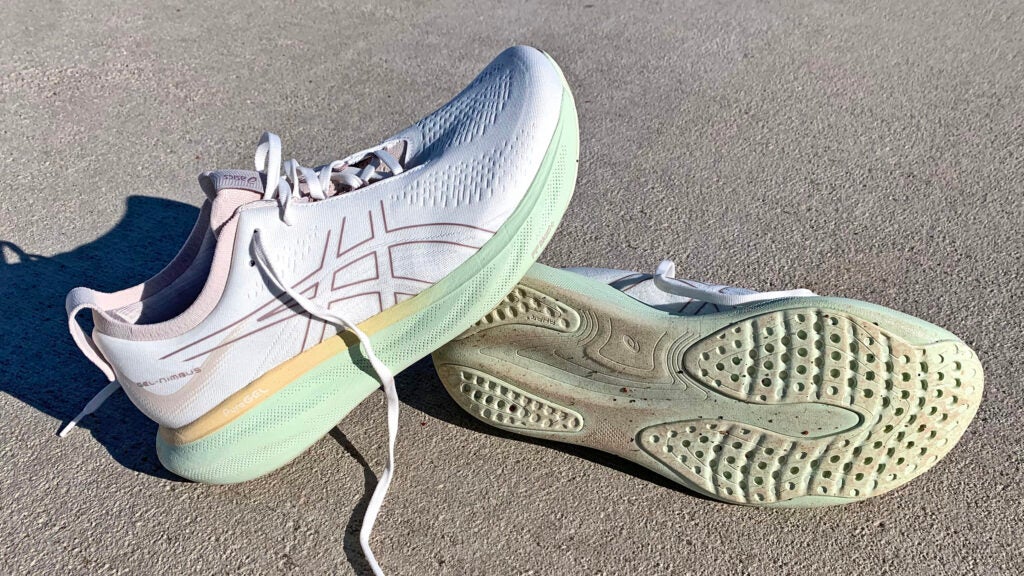No products in the cart.
Outdoor Adventure
First Run: Asics All-New Gel-Nimbus 25
Outside’s long reads email newsletter features our strongest writing, most ambitious reporting, and award-winning storytelling about the outdoors.
Asics Gel-Nimbus 25 Review
MSRP: $160
Weight: 9.0 oz. (women’s size 8), 10.2 oz. (men’s size 9)
Stack Height: 40.5mm/32.5mm (women), 41.5mm/33.5mm (men)
Heel-Toe Offset: 8mm
A decade ago, as a minimalist shoe revolution was waning, maximally cushioned models emerged as the primary design ethos for everyday training shoes and long-distance racing shoes. Now it appears that we’ve entered an era of super-max shoes as a new crop of extremely cushy, high-stack models are on the way to running stores.
One of the first to drop this year will be the Asics Gel-Nimbus 25, which debuts on February 1. With 20 percent more FlyteFoam Blast+ foam than the previous edition of this neutral training shoe and an oversized 41.5mm stack height under the heel, it looks like a cartoonishly inflated drawing of Asics’ franchise cushioned trainer. What’s interesting about the Nimbus’s ultra-thick single-density midsole isn’t that it exceeds the World Athletics’ 40mm height limit—because that only applies to shoes used in competition by elite runners and several other new models have blissfully blown by that prohibition—it’s that the foam serves up a soft, flowy ride with buttery smooth transitions and a mildly energetic sensation in every stride.
The foam used in the GEL-Nimbus 25, called FlyteFoam Blast+ Eco, is a more sustainable compound that incorporates 20 percent bio-based material. It produces a similarly bouncy sensation to that of Asics’ shoes that have already incorporated it—most notably the NovaBlast 3 and GlideRide 3. But it’s not just midsole foam that makes the new Nimbus special. There’s a lighter and softer formulation of Asics’ signature gel cushioning additive, now called PureGEL, embedded in the heel. And the Nimbus 25 no longer features a midfoot Trusstic system (shank) because the new midsole formulation provides a smooth transition from heel to toe without the need for supplemental torsional rigidity.
All of those design elements contribute to the velvety ride, but so too does the slightly lower heel-toe offset. Whereas last year’s men’s Nimbus had a 10mm drop and the women’s was 13mm this year’s edition now has a universal 8mm offset with more bouncy cushioning under the forefoot.

Having had a chance to see and touch (but not try on) the new Nimbus at a running industry trade show in December, I was curious to see how they felt on the run. When I received a demo pair in my size last week, I quickly laced them up and headed out for a run. At slow to moderate paces they felt soft and sublime, with a consistent creaminess and a smooth rolling sensation. When I revved up my efforts on a few of my runs and even clicked off four 200-meter repeats at 10K pace at a local high school track I found that, while it takes a little bit more effort to run faster paces (especially given the weight and moderate responsiveness of the foam), the shoe held its own and didn’t feel sluggish or clunky. It felt even better when I ran three miles at tempo pace, but it shined most when running at a cruise for what turned out to be just short of 10 miler. What I liked best about the Gel-Nimbus 25 was that the foam felt soft but also stable, not at all like marshmallowy soft midsoles that bottom out, become unstable at higher speeds or start to break down after 100 miles or so.
A few other features of the GEL-Nimbus 25 are worth noting. First, the upper has been changed from an engineered mesh material to a breathable, semi-stretchy knit fabric with a bootie fit from a fully gusseted knit tongue. I found the soft knit sufficiently held my feet in place, and the interior and considerably padded heel collar felt comfy and plush. The outsole includes three segments of perforated rubber (two pads of durable rubber on the heel, one larger segment of lighter and more responsive rubber under the forefoot) plus large sections of exposed foam, which combine to keep the shoe as light as possible, resist wear, and, I discovered, grip well on dry and wet surfaces.
Overall, I liked running in the Gel-Nimbus 25. Having run in Asics’ lighter SuperBlast—a super-max shoe with a dual-density midsole and an inflated 45.5mm/37.5mm geometry—I would have appreciated the new Nimbus more if it was an ounce or so lighter. But while the Nimbus’s FlyteFoam Blast+ foam is more dense and slightly heavier than the combination of FlyteFoam Blast+ and light and energetic FlyteFoam Blast Turbo in the SuperBlast, it delivers an exceptionally cushy ride without sacrificing gait dynamics.
I loved the new Nimbus’s interior comfort, plush and consistently smooth ride at moderate paces, and the feeling of substantial support delivered in each stride. The shoe stands out as an example of one place where the super-max credo of “more is better” proves true. Going forward, I’ll definitely use it often, mostly for long runs and recovery days.
Source link

